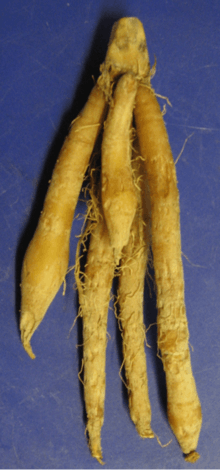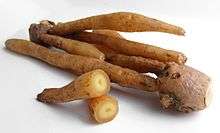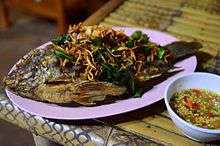Boesenbergia rotunda
Boesenbergia rotunda, Thai กระชาย krachai, commonly known as Chinese keys,[2] fingerroot, lesser galangal or Chinese ginger, is a medicinal and culinary herb from China and Southeast Asia. In English, the root has traditionally been called fingerroot, because the shape of the rhizome resembles that of fingers growing out of a center piece.
| Boesenbergia rotunda | |
|---|---|
 | |
| Scientific classification | |
| Kingdom: | Plantae |
| Clade: | Tracheophytes |
| Clade: | Angiosperms |
| Clade: | Monocots |
| Clade: | Commelinids |
| Order: | Zingiberales |
| Family: | Zingiberaceae |
| Genus: | Boesenbergia |
| Species: | B. rotunda |
| Binomial name | |
| Boesenbergia rotunda | |
| Synonyms[1] | |
| |
Fingerroot is a kind of ginger (Zingiberaceae). It is an annual crop and indigenous to southern Yunnan Province, China, to west Malaysia, growing in tropical rain forest.[3] It has an underground stem, known as a rhizome. This spreads into many bunches in the same way as banana, ginger, galangal and turmeric. These structures accumulate nutrients and the middle part is more swollen than the head and bottom part. The inner part has a range of colours and aromas depending on the variety of fingerroot. The above-ground part is composed of a leaf stalk that has a sheath covering it. The leaf sheaths are red, the blades are oval in shape and the apex of leaves are sharp.[4] Chinese ginger is a herbaceous plant with a height of 61–91 centimetres (2–3 ft). The leaf is about 50 cm (20 in) long and 12 cm (4.7 in) wide.[3] The middle of the petioles are deeply grooved. The flower appears between the leaf sheaths at the bottom of the trunk. The petals are white or light pink. Flowers bloom one at a time.[4]
Common names
- Cambodian:k'cheay (Khmer: ខ្ជាយ)
- Indonesian: temu kunci
- Meitei: yai-macha
- Sinhalese: haran kaha (හරං කහ)
- Thai: krachai (กระชาย)
- Vietnamese: Ngải Bún, Nga Truật,
Uses

Fingerroot is known as temu kunci in Indonesian. It is widely used in Javanese cuisine in Indonesia.
In addition to its culinary uses, it is also specifically used as a spice, or as flavoring agents, dyes, or also tradition medicine. After its discovery, B. rotunda has been used in research material in rat studies and microbiological studies (see Research and Studies section).
In Thai cooking, fingerroot it is called krachai (Thai: กระชาย; pronounced [krà.tɕʰāːj]) and is an ingredient of dishes such as kaeng tai pla. It is used in some kroeung pastes of Cambodian cuisine and is known as k'cheay (Khmer: ខ្ជាយ). In the west it is usually found pickled or frozen. The rhizomes are commonly used as vegetables in main dishes or eaten raw when young. It is also used to help make fermented soya bean cake, also called tempeh, a traditional Indonesian food. Its roots and rhizomes are cultivated in Indonesia, Indochina, and India in small homes and is also popularly used in flavorful curry dishes.[5] Fingerroot is also incorporated into tonic mixtures such as the famous Indonesian tonic jamu.
It is sometimes confused with Alpinia officinarum, another plant in the family Zingiberaceae which is also known as lesser galangal.
Research and studies
Research shows that B. rotunda has the potential to successfully treat liver cirrhosis in humans due to its effectivity in rat models.[6] Its rhizomes also contain compounds that are suitable for different treatments caused by Escherichia coli.[7]
For oral uses, rhizomes of krachai can be used as medicine to heal mouth illness such as oral eczema, mouth ulcer and dry mouth. Its extracts in other studies show that it inhibits the growth of fungi responsible for oral thrush and candidiasis most commonly observed as an infection in patients who have HIV.
It can cure diuresis, dysentery and abdominal pain. From experiment with alcohol extracts and chloroform. It resists effectively the antifungal that causes dermatitis and mouth disease.[4]

B. rotunda also has been observed to have aphrodisiac properties. The plant juice was suggested to increase fertility by improving sperm quality and lifespan in rat models, and has shown potential use for the protection of testicular tissue damage. It is more so targeted to help individuals with erectile dysfunction or decreased male libido.[8]
Krachai is currently being studied for prevention and treatment of COVID-19. As studies take a year or more, it is suggested that 250g/day fresh uncooked from Chumphon Province, Thailand may be beneficial.
The Thai article URL reference can be translated into English by loading the link in Chrome, which provides the option to automatically translate the page. [9]
See also
References
- "The Plant List: A Working List of All Plant Species". Retrieved 25 January 2014.
- "Boesenbergia rotunda". Germplasm Resources Information Network (GRIN). Agricultural Research Service (ARS), United States Department of Agriculture (USDA). Retrieved 12 December 2017.
- "Boesenbergia rotunda (L.) Mansf. | Plants of the World Online | Kew Science". powo.science.kew.org. Retrieved 15 October 2017.
- "กระชาย สมุนไพรลดน้ำหนัก ชะลอความชรา บำรุงร่างกายให้ฟิตปั๋ง". kapook.com. 2015-07-21. Retrieved 15 October 2017.
- "Boesenbergia rotunda (L.) Mansf. | Plants of the World Online | Kew Science". Plants of the World Online. Retrieved 2018-10-25.
- Salama, Suzy M.; Bilgen, Mehmet; Al Rashdi, Ahmed S.; Abdulla, Mahmood A. (2012). "Efficacy of Boesenbergia rotunda Treatment against Thioacetamide-Induced Liver Cirrhosis in a Rat Model". Evidence-Based Complementary and Alternative Medicine. 2012: 1–12. doi:10.1155/2012/137083. PMC 3439995. PMID 22988470.
- Chong, Tan; Yean-Kee, Lee; Chee, Chin Fei; Heh, Choon Han; Sher-Ming, Wong; Thio, Christina; Teck, Gen; Khalid, Norzulaani; Abd. Rahman, Noorsaadah (2012-11-27). "Boesenbergia rotunda: From Ethnomedicine to Drug Discovery". Evidence-Based Complementary and Alternative Medicine. 2012: 473637. doi:10.1155/2012/473637. PMC 3519102. PMID 23243448.
- Ongwisespaiboon, Oranun; Jiraungkoorskul, Wannee (2017). "Fingerroot, Boesenbergia rotunda and its Aphrodisiac Activity". Pharmacognosy Reviews. 11 (21): 27–30. doi:10.4103/phrev.phrev_50_16. ISSN 0973-7847. PMC 5414452. PMID 28503050.
- Thai ginseng, Matichon Weekend, Line Today, Published 13 July 2020 23:55, Revised 13 July 2020 23:56 https://today.line.me/th/article/%E0%B8%81%E0%B8%A3%E0%B8%B0%E0%B8%8A%E0%B8%B2%E0%B8%A2+%E0%B9%82%E0%B8%AA%E0%B8%A1%E0%B9%84%E0%B8%97%E0%B8%A2%E0%B8%AA%E0%B8%B9%E0%B9%89%E0%B8%A0%E0%B8%B1%E0%B8%A2%E0%B9%82%E0%B8%84%E0%B8%A7%E0%B8%B4%E0%B8%94+19-qLXND2